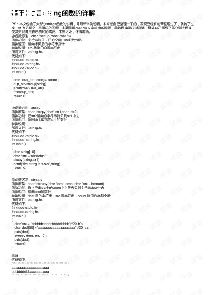

编程语言中的字符串,用双引号引起来的几个字符.如"Abc","一天".String类是不可变(final)的,对String类的任何改变,都是返回一个新的String类对象.
这样的话把String类的引用传递给一个方法,该方法对String的任何改变,对原引用指向的对象没有任何影响,这一点和基本数据类型相似.
s1="abc";
①.、用法
string类的构造函数:

string(const char*s);//用c字符串s初始化string(int n,char c);//用n个字符c初始化
const charoperator[](int n)const;const charat(int n)const;charoperator[](int n);charat(int n);
operator[]和at()均返回当前字符串中第n个字符的位置,但at函数提供范围检查,当越界时会抛出out_of_range异常,下标运算符[]不提供检查访问.
const char*data()const;//返回一个非null终止的c字符数组const char*c_str()const;//返回一个以null终止的c字符串
int copy(char*s,int n,int pos=0)const;//把当前串中以pos开始的n个字符拷贝到以s为起始位置的字符数组中,返回实际拷贝的数目.
扩展资料:
①.、string的特性描述:
int capacity()const; //返回当前容量(即string中不必增加内存即可存放的元素个数)
int max_size()const; //返回string对象中可存放的最大字符串的长度
int size()const; //返回当前字符串的大小
int length()const; //返回当前字符串的长度
bool empty()const; //当前字符串是否为空
void resize(int len,char c);//把字符串当前大小置为len,并用字符c填充不足的部分
string类重载运算符operator用于输入,同样重载运算符operator用于输出操作.函数getline(istream in,string s);用于从输入流in中读取字符串到s中,以换行符'\n'分开.
string operator=(const string s);//把字符串s赋给当前字符串
string assign(const char *s);//用c类型字符串s赋值
string assign(const char *s,int n);//用c字符串s开始的n个字符赋值
string assign(const string s);//把字符串s赋给当前字符串
string assign(int n,char c);//用n个字符c赋值给当前字符串
string assign(const string s,int start,int n);//把字符串s中从start开始的n个字符赋给当前字符
string assign(const_iterator first,const_itertor last); //把first和last迭代器之间的部分赋给字符串
string operator+=(const string s);//把字符串s连接到当前字符串的结尾
string append(const char *s); //把c类型字符串s连接到当前字符串结尾
string append(const char *s,int n);//把c类型字符串s的前n个字符连接到当前字符串结尾
string append(const string s); //同operator+=()
string append(const string s,int pos,int n);//把字符串s中从pos开始的n个字符连接到当前字符串的结尾
string append(int n,char c); //在当前字符串结尾添加n个字符c
string append(const_iterator first,const_iterator last);//把迭代器first和last之间的部分连接到当前字符串的结尾
string substr(int pos = 0,int n = npos) const;//返回pos开始的n个字符组成的字符串
int find(char c, int pos = 0) const;//从pos开始查找字符c在当前字符串的位置
int find(const char *s,int pos = 0) const;//从pos开始查找字符串s在当前串中的位置
int find(const char *s, int pos, int n) const;//从pos开始查找字符串s中前n个字符在当前串中的位置
int find(const string s,int pos = 0) const;//从pos开始查找字符串s在当前串中的位置 //查找成功时返回所在位置,失败返回string::npos的值
int rfind(char c, int pos = npos) const;//从pos开始从后向前查找字符c在当前串中的位置
int rfind(const char *s, int pos = npos) const;
int rfind(const char *s, int pos, int n = npos) const;
int rfind(const string s,int pos = npos) const; //从pos开始从后向前查找字符串s中前n个字符组成的字符串在当前串中的位置,成功返回所在位置,失败时返回string::npos的值
int find_first_of(char c, int pos = 0) const;//从pos开始查找字符c第一次出现的位置
int find_first_of(const char *s, int pos = 0) const;
int find_first_of(const char *s, int pos, int n) const;
int find_first_of(const string s,int pos = 0) const; //从pos开始查找当前串中第一个在s的前n个字符组成的数组里的字符的位置.查找失败返回string::npos
int find_first_not_of(char c, int pos = 0) const;
int find_first_not_of(const char *s, int pos = 0) const;
int find_first_not_of(const char *s, int pos,int n) const;
int find_first_not_of(const string s,int pos = 0) const; //从当前串中查找第一个不在串s中的字符出现的位置,失败返回string::npos
int find_last_of(char c, int pos = npos) const;
int find_last_of(const char *s, int pos = npos) const;
int find_last_of(const char *s, int pos, int n = npos) const;
int find_last_of(const string s,int pos = npos) const;
int find_last_not_of(char c, int pos = npos) const;
int find_last_not_of(const char *s, int pos = npos) const;
int find_last_not_of(const char *s, int pos, int n) const;
int find_last_not_of(const string s,int pos = npos) const; //find_last_of和find_last_not_of与find_first_of和find_first_not_of相似,只不过是从后向前查找.
string类的替换函数:
string replace(int p0, int n0,const char *s);//删除从p0开始的n0个字符,然后在p0处插入串s
string replace(int p0, int n0,const char *s, int n);//删除p0开始的n0个字符,然后在p0处插入字符串s的前n个字符
string replace(int p0, int n0,const string s);//删除从p0开始的n0个字符,然后在p0处插入串s
string replace(int p0, int n0,const string s, int pos, int n);//删除p0开始的n0个字符,然后在p0处插入串s中从pos开始的n个字符
string replace(int p0, int n0,int n, char c);//删除p0开始的n0个字符,然后在p0处插入n个字符c
string replace(iterator first0, iterator last0,const char *s);//把[first0,last0)之间的部分替换为字符串s
string replace(iterator first0, iterator last0,const char *s, int n);//把[first0,last0)之间的部分替换为s的前n个字符.
string replace(iterator first0, iterator last0,const string s);//把[first0,last0)之间的部分替换为串s
string replace(iterator first0, iterator last0,int n, char c);//把[first0,last0)之间的部分替换为n个字符c
string replace(iterator first0, iterator last0,const_iterator first, const_iterator last);//把[first0,last0)之间的部分替换成[first,last)之间的字符串.
string类的插入函数:
string insert(int p0, const char *s);
string insert(int p0, const char *s, int n);
string insert(int p0,const string s);
string insert(int p0, int n, char c);//此函数在p0处插入n个字符c
iterator insert(iterator it, char c);//在it处插入字符c,返回插入后迭代器的位置
void insert(iterator it, const_iterator first, const_iterator last);//在it处插入[first,last)之间的字符
void insert(iterator it, int n, char c);//在it处插入n个字符c
string类的删除函数
iterator erase(iterator first, iterator last);//删除[first,last)之间的所有字符,返回删除后迭代器的位置.
iterator erase(iterator it);//删除it指向的字符,返回删除后迭代器的位置.
string erase(int pos = 0, int n = npos);//删除pos开始的n个字符,返回修改后的字符串.
string类的迭代器处理:
string类提供了向前和向后遍历的迭代器iterator,迭代器提供了访问各个字符的语法,类似于指针操作,迭代器不检查范围.
用string::iterator或string::const_iterator声明迭代器变量,const_iterator不允许改变迭代的内容.常用迭代器函数有:
const_iterator begin()const; iterator begin(); //返回string的起始位置
const_iterator end()const; iterator end(); //返回string的最后一个字符后面的位置
const_iterator rbegin()const; iterator rbegin(); //返回string的最后一个字符的位置
const_iterator rend()const; iterator rend(); //返回string第一个字符位置的前面
rbegin和rend用于从后向前的迭代访问,通过设置迭代器string::reverse_iterator或string::const_reverse_iterator实现
字符串流处理:
通过定义ostringstream和istringstream变量实现,在#include sstream头文件中.
例如:
string input("hello,this is a test");
istringstream is(input);
ostringstream os;
coutos.str();
参考资料:
百度百科——string
C语言提供了丰富的字符串处理函数, 大致可分为字符串的输入、输出、合并、修改、比较、转换、复制、搜索几类. 使用这些函数可大大减轻编程的负担.用于输入输出的字符串函数, 在使用前应包含头文件"stdio.h" ; 使用其它字符串函数则应包含头文件"string.h". 下面介绍几个最常用的字符串函数.
①字符串输出函数 puts 格式: puts (字符数组名) 功能:把字符数组中的字符串输出到显示器. 即在屏幕上显示该字符串
#include"stdio.h"
main()
{
static char c[]="BASIC\ndBASE";
puts(c);
}
printf("input string:\n");
gets(st);
puts(st);
#include"string.h"
printf("input your name:\n");
puts(st1);
puts(st1);printf("\n");
本函数也可用于比较两个字符串常量,或比较数组和字符串常量.
{ int k;
printf("input a string:\n");
gets(st1);
static char st[]="C language";
k=strlen(st);
printf("The lenth of the string is %d\n",k);
String是C++、java、VB等编程语言中的字符串,用双引号引起来的几个字符,如"Abc","一天".
在java、C#中,String类是不可变的,对String类的任何改变,都是返回一个新的String类对象. String 对象是?System.Char?对象的有序集合,用于表示字符串.String 对象的值是该有序集合的内容,并且该值是不可变的.
string字符创的用法:
①.、字符串输出函数puts,格式:puts (字符数组名),功能:把字符数组中的字符串输出到显示器.
string在c语言中的意思是System.Char对象的有序集合,用于表示字符串.
String就是C等编程语言中的字符串,用双引号引起来的几个字符.
在java、C#中,String类是不可变的,对String类的任何改变,都是返回一个新的String类对象.String对象是?System.Char?对象的有序集合,用于表示字符串.String对象的值是该有序集合的内容,并且该值是不可变的.
可以使用以下方法之一来创建string对象:
通过给String变量指定一个字符串.
通过使用String类构造函数.
通过使用字符串串联运算符(+).
通过检索属性或调用一个返回字符串的方法.
通过格式化方法来转换一个值或对象为它的字符串表示形式.
以上就是土嘎嘎小编为大家整理的c语言string函数相关主题介绍,如果您觉得小编更新的文章只要能对粉丝们有用,就是我们最大的鼓励和动力,不要忘记讲本站分享给您身边的朋友哦!!